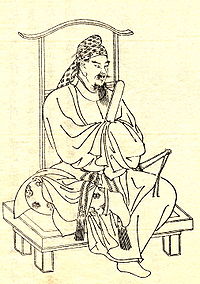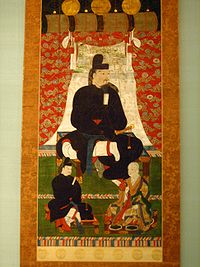- Fujiwara no Kamatari
-
Fujiwara no Kamatari (藤原 鎌足, 614 – November 14, 669) was a Japanese statesman, courtier and politician during the Asuka period.[1]
Kamatari was the founder of the Fujiwara clan in Japan. His birth clan was the Nakatomi. He was the son of Nakatomi no Mikeko, and his birth name was Nakatomi no Kamatari (中臣 鎌足). Just before his death, he received the surname Fujiwara from Emperor Tenji.
He was a friend and supporter of the Prince Naka no Ōe, later Emperor Tenji. Kamatari was the head of the Jingi no Haku, or Shinto ritualists; as such, he was one of the chief opponents of the increasing power and prevalence of Buddhism in the court, and in the nation. As a result, in 645, Prince Naka no Ōe and Kamatari made a coup d'état in the court. They slew Soga no Iruka who had a strong influence over Empress Kōgyoku; thereafter, Iruka's father, Soga no Emishi, committed suicide.
Empress Kōgyoku was forced to abdicate in favor of her younger brother, who became Emperor Kōtoku; Kōtoku then appointed Kamatari naidaijin (Inner Minister).
Kamatari was a leader in the development of what became known as the Taika Reforms, a major set of reforms based on Chinese models and aimed at strengthening Imperial power. He one of the principle editors responsible for the development of the Japanese legal code known as Sandai-kyaku-shiki, sometimes referred to as the Rules and Regulations of the Three Generations.[2]
During his life Kamatari continued to support Prince Naka no Ōe, who became Emperor Tenji in 661. Tenji granted him the highest rank Taishokan and a new clan name, Fujiwara, as honors.
His son was Fujiwara no Fuhito (or Fubito). Kamatari's nephew, Nakatomi no Omimaro became head of Ise Shrine, and passed down the Nakatomi name.
Three unifiers of Japan were related to the Fujiwara:
- Oda Nobunaga's great-grand niece married into the Fujiwara.
- Toyotomi Hideyoshi's second wife was distantly related by marriage to the Fujiwara.
- Tokugawa Ieyasu's heirs married into the Fujiwara.
Among his descendants were Fumimaro Konoe the 34th/38th/39th Prime Minister of Japan and Konoe's grandson Morihiro Hosokawa the 79th Prime Minister of Japan and is also a descendant of the Hosokawa clan via the Ashikaga clan of the Minamoto clan. {Tokugawa Ieyasu first wife was also related to the Minamoto clan}.
In the 13th century, the main line of the Fujiwara family split into five houses: Konoe, Takatsukasa, Kujō, Nijō and Ichijō. These five families in turn provided regents for the Emperor, and were thus known as the Five Regent Houses. The Tachibana clan (samurai) also claim descent from the Fujiwara. Emperor Montoku of the Taira clan was descended through his mother of the Fujiwara. {Oda Nobunga also claimed descent from the Taira clan}.
Until the marriage of the Crown Prince Hirohito (posthumously Emperor Shōwa) to Princess Kuni Nagako (posthumously Empress Kōjun) in January 1924, the principal consorts of emperors and crown princes had always been recruited from one of the Sekke Fujiwara. Imperial princesses were often married to Fujiwara lords - throughout a millennium at least. As recently as Emperor Shōwa's third daughter, the late former Princess Takanomiya (Kazoku), and Prince Mikasa's elder daughter, the former Princess Yasuko, married into Takatsukasa and Konoe families, respectively. Empress Shōken was a descendant of the Fujiwara clan and through Hosokawa Gracia of the Minamoto clan. Likewise a daughter of the last Tokugawa Shogun married a second cousin of Emperor Shōwa.
See also
- Tōshi Kaden, a bibliographic record
Notes
- ^ Nussbaum, Louis-Frédéric. (2005). "Fujiwara no Tadahira" in Japan Encyclopedia, p. 203 at Google Books; Brinkley, Frank et al. (1915). A History of the Japanese People from the Earliest Times to the End of the Meiji Era, p. 203. at Google Books
- ^ Brinkley, p. 177. at Google Books
References
- Brinkley, Frank and Dairoku Kikuchi. (1915). A History of the Japanese People from the Earliest Times to the End of the Meiji Era. New York: Encyclopedia Britannica. OCLC 413099]
- Nussbaum, Louis-Frédéric and Käthe Roth. (2005). Japan encyclopedia. Cambridge: Harvard University Press. 10-ISBN 0-674-01753-6; 13-ISBN 978-0-674-01753-5; OCLC 58053128
- Titsingh, Isaac. (1834). Nihon Odai Ichiran; ou, Annales des empereurs du Japon. Paris: Royal Asiatic Society, Oriental Translation Fund of Great Britain and Ireland. OCLC 5850691
Kamatari Fuhito NANKE branch HOKKE branch SHIKIKE branch KYŌKE branch Muchimaro Fusasaki Umakai Maro Toyonari Nakamaro Nagate Kiyokawa Matate Uona Kaedemaro Hirotsugu Kiyonari Yoshitsugu Momokawa Kurajimaro Hamanari Tsuginawa Asakari Uchimaro Fujinari Sonondo Tanetsugu Otsugu Fuyutsugu Toyozawa Nakanari Yoshifusa Yoshisuke Yoshikado Murao Mototsune Hidesato Tokihira Nakahira Tadahira Morosuke Saneyori Tamemitsu Kinsue Koretada Kaneie Kanemichi Yoritada Michinaga Michikane Michitaka Kintō Yorimichi Norimichi Nagaie Korechika Morzane Nobunage Tadaie Moromichi Toshitada Tadazane Toshinari Yorinaga Tadamcihi Sadaie Kanezane Motofusa Motozane - In the 13th century, the main line of the Fujiwara family split into five families or houses: the Kujō, Nijō and Ichijō (descendants of Kanezane); and also the Konoe and Takatsukasa (descendants of Motozane).
Categories:- 614 births
- 669 deaths
- Fujiwara clan
- People of Asuka period Japan
Wikimedia Foundation. 2010.


